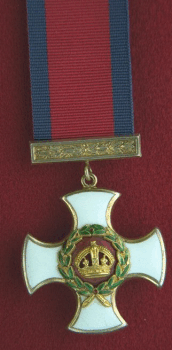
DISTINGUISHED SERVICE ORDER (DSO)
The order was established for rewarding individual instances of meritorious or distinguished service in war. This is a military order for officers only, and while normally given for service under fire or under conditions equivalent to service in actual combat with the enemy, it was awarded between 1914 and 1916 under circumstances which could not be regarded as under fire. After 01 January 1917, commanders in the field were instructed to recommend this award only for those serving under fire. Prior to 1943, the order could be given only to someone Mentioned-in-Dispatches. The order is generally given to officers in command, above the rank of Lieutenant-Colonel and awards to ranks below this are usually for a high degree of gallantry just short of deserving the Victoria Cross.
BARS
A bar is awarded for an act which would have earned the order in the
first place. The bar is plain gold with an Imperial Crown in the centre.
The year of the award is engraved on the reverse.
DESCRIPTION
A gold cross, enamelled gold and edged in gold.
OBVERSE
In the centre, within a wreath of laurel, enamelled green, the Imperial
Crown in gold upon a red enamelled ground.
REVERSE
Within a wreath of laurel, enamelled green, the Royal Cypher in gold
upon a red enamelled ground.
MOUNTING
A ring at the top of the medal attaches to a ring at the bottom of
a gold bar, ornamented with laurel. At the top of the ribbon is a second
gold bar ornamented with laurel.
RIBBON
The red ribbon is 1.125 inches wide with narrow blue edges. A rosette
is worn on the ribbon in undress to signify the award of a bar.
DATES
The Royal Warrant was published in the London Gazette on 09 November
1886.
NAMING
Officially unnamed, some recipients have privately had their names
engraved on the back of the suspension bar.
![]()
~Squadrons~
~Order of
Battle~ ~Airfields~ ~Aircraft~ ~Daily
Operations~ ~Stats~ ~Strike
Photos~ ~Mining
Codes~ ~Home~
~Sign
My Guestbook~ ~View
My Guestbook~